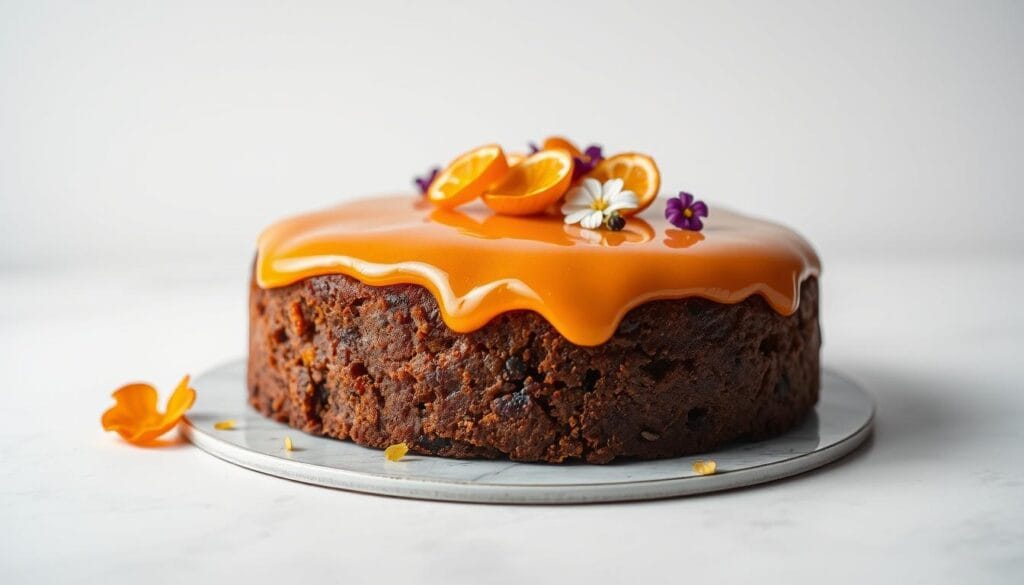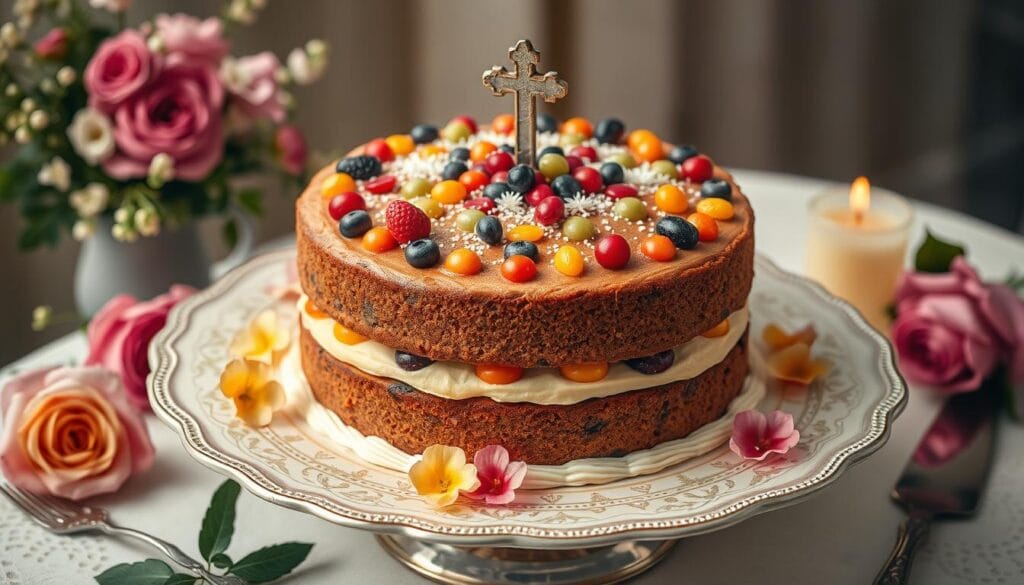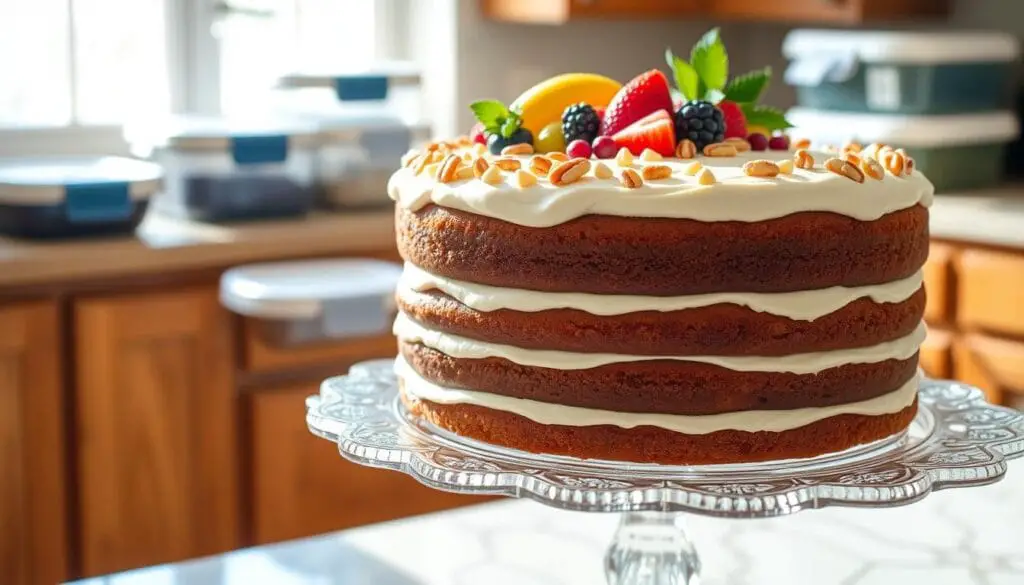As winter’s chill hits the windows, a sense of excitement grows. The smell of spices and fresh pastry fills the air. It invites you to try a slice of history – the Bishop’s Cake. This treat, rooted in Anglican traditions, has won hearts and taste buds for years.
Remembering Bishop’s Cake on our holiday table brings joy. The soft cake and almond flavor were amazing. The buttercream frosting on top felt like a royal crown. It was a taste of tradition, celebration, and future joy.
Key Takeaways
- Bishop’s Cake is a traditional holiday dessert with a rich history and distinct flavors.
- The cake is closely associated with the Anglican church, making it a cherished ecclesiastical treat.
- The recipe features a moist, almond-flavored cake topped with a creamy buttercream frosting.
- Baking Bishop’s Cake is a beloved holiday tradition that connects us to the past and celebrates the present.
- This festive confection is a must-try for those seeking a taste of history and a touch of holiday sweetness.
The Origins of Bishop’s Cake
The bishop’s cake is a treasured ecclesiastical treat with Anglican roots. It’s believed to have started with bishops, who shaped the church’s food traditions. This traditional recipe is loved in Episcopal and Anglican celebrations.
Tracing the Roots of This Festive Delight
The bishop’s cake dates back to the Middle Ages. During this time, the Anglican church was key in Europe’s food scene. Bishops, seen as spiritual leaders, hosted big feasts where this cake was served.
Over time, the bishop’s cake grew from a simple treat to a favorite anglican dessert. It became a big part of church events and holidays. The clerical pastry showed the church’s power and connected the clergy with their community.
“The bishop’s cake has been a cherished part of Anglican traditions for centuries, a testament to the enduring influence of the church and its leaders.”
Today, the bishop’s cake is still a favorite sacerdotal sweetness. It shows the rich prelatic delight passed down through generations. Its lasting popularity highlights the Anglican church’s lasting impact on food traditions.
Ingredients for a Scrumptious Bishop’s Cake
Making a traditional bishop’s cake needs the right ingredients. At its core is the buttercream frosting with a hint of almond flavor. This mix, along with classic fruit cake elements, keeps the cake true to its traditional recipe and festive baking spirit.
To make a bishop’s cake that’s a treat for the senses, you’ll need these key items:
- Butter, for the rich and creamy buttercream frosting
- Granulated sugar, to sweeten the cake and frosting
- Eggs, to provide structure and a tender crumb
- Flour, the backbone of the cake
- Almond extract, for the signature flavor
- Candied glazed fruit, such as cherries, pineapple, and citrus, for a festive touch
- Spices like cinnamon, nutmeg, and cloves, to evoke the warmth of the holiday season
With these ingredients, you’re ready to make a bishop’s cake that honors its rich history and traditions.
Step-by-Step Instructions for Baking Success
Making the perfect Bishop’s Cake is a detailed process. It’s great for both experienced bakers and beginners. Follow these steps to master the traditional bishop’s cake recipe. You’ll enjoy a wonderful festive baking experience.
After the traditional recipe cools, you can add your favorite frosting or glaze. Enjoy this mitered indulgence with your loved ones.
Baking is an art that gets better with practice. With a bit of effort, you’ll make delicious bishop’s cakes that wow your guests. They’ll become a special part of your festive baking traditions.
Bishop’s Cake: A Holiday Tradition
The bishop’s cake is a treasured part of holiday celebrations in Anglican and Episcopal communities. It’s a classic Christmas dessert with roots going back centuries. It’s a favorite holiday treat for many families.
The history of the bishop’s cake goes back to the Middle Ages. It was linked to St. Nicholas’ feast or other religious festivals. The recipe and traditions have changed over time. But its importance in festive baking stays strong.
Today, the bishop’s cake holds a special place in holiday celebrations. Its unique look and rich, buttery taste make it a beloved part of many families’ traditions.
“The bishop’s cake is a true testament to the enduring power of culinary traditions. It’s a delightful way to connect with the past and celebrate the joy of the present.”
The bishop’s cake is a timeless holiday treat. It’s enjoyed as a centerpiece on the holiday table or shared with loved ones. It brings joy and nostalgia to all who enjoy it.
Variations and Twists on the Classic Recipe
The traditional bishop’s cake recipe is still loved by many. But today, bakers are adding their own twist to this festive baking classic. They’re mixing up flavors and presentation, making the crosier cake a modern favorite.
Putting a Modern Spin on an Ancient Treat
Some bakers add a zing with lemon or orange to the classic bishop’s cake. Others spice it up with cardamom or cinnamon. To make it fancy, they top it with a glaze or powdered sugar.
Bakers are also getting creative with the cake’s shape. You might see bishop’s cakes shaped like a crosier or even tiny cakes for everyone to enjoy. These new shapes add a fun twist to this old-timey treat.

Whether you stick to the traditional or try something new, the bishop’s cake is full of possibilities. By mixing old with new, bakers can wow their guests with their unique festive baking creations.
The Symbolism and Significance of Bishop’s Cake
The bishop’s cake, an ecclesiastical treat, holds deep meaning in the Anglican church. It’s more than a tasty pastry; it symbolizes the spiritual and ceremonial sides of the Episcopal tradition.
The bishop’s cake is linked to the bishop’s role, a key figure in the Anglican church. Its mitered shape mirrors the bishop’s ceremonial hat. This clerical pastry stands as a symbol of the bishop’s spiritual leadership and the Anglican church’s rich history.
The bishop’s cake is filled with sacerdotal sweetness. It uses top-notch ingredients like butter, eggs, and sugar. This shows the respect and value given to this mitered indulgence. Its making and serving are filled with ritual, adding to its sacred status in the Episcopal tradition.
Enjoying the bishop’s cake at special events like ordinations and confirmations highlights its importance. This anglican dessert represents the community’s shared faith. It connects them to their religious heritage.
“The bishop’s cake is not just a delicious treat, but a symbol of the enduring legacy of the Anglican church. It is a testament to the enduring power of tradition and the deep-rooted spiritual connections that bind the faithful together.”
When the bishop’s cake appears at Episcopal and Anglican gatherings, it reminds everyone of their faith’s sacred nature. This clerical pastry embodies the sacerdotal sweetness that enriches their religious lives. It’s a treasured and meaningful part of the Anglican tradition.
Serving and Presentation: Elevating the Episcopal Confection
Serving your bishop’s cake right is key. This holiday treat needs a special display. It should show off its beauty and meaning. With the right plating and garnishing, your pontifical pâtisserie will impress your guests.
Making a Memorable Impression with Your Bishop’s Cake
Choose a fancy serving platter or stand that matches your bishop’s cake‘s design. A simple white or neutral-toned pedestal works well. Add fresh flowers, evergreen sprigs, or other natural elements around the base for a stunning look.
- Put the bishop’s cake in the center of the platter, making sure it’s level.
- Lightly dust the top with powdered sugar or cocoa powder to highlight the layers.
- Decorate the cake with candied citrus peels, sugared cranberries, or rosemary sprigs.
- Place a decorative bishop’s mitre or cross nearby to highlight the cake’s religious theme.
By presenting your bishop’s cake with care, you turn a simple dessert into a memorable festive baking moment. It will impress your guests and honor the tradition of this ecclesiastical delight.

“The true beauty of a bishop’s cake lies not only in its delicious flavor, but in the care and attention paid to its presentation.”
Bishop’s Cake: A Timeless Delight
The bishop’s cake has been loved for centuries. It’s a special treat in Anglican and Episcopal dessert traditions. It’s more than just a sweet treat; it’s a symbol of faith and community.
The bishop’s cake connects us to our past and present. Its traditional recipe lets us enjoy a piece of history. It’s a clerical pastry that’s still loved today.
The bishop’s cake brings people together. It’s enjoyed at church events, family gatherings, and quiet moments. It reminds us of tradition, nostalgia, and spiritual connection.
“The bishop’s cake is more than just a dessert – it’s a piece of history, a symbol of our faith, and a way to connect with our community. Each bite is a journey through time, a reminder of the enduring power of traditions that bind us together.”
The bishop’s cake remains a beloved part of our heritage. It’s a delicious link between the past and present. It celebrates the lasting power of tradition.
Storage and Shelf Life: Keeping Your Bishop’s Cake Fresh
Keeping your homemade bishop’s cake fresh is key to enjoying it fully. Whether for a festive event or personal indulgence, the right storage makes a big difference.
Store your bishop’s cake in a way that protects it from moisture and sunlight. If it has buttercream frosting or glazed fruit, use an airtight container at room temperature. This keeps the frosting fresh and the cake moist.
For an unfrosted bishop’s cake, the fridge is your friend. It can last a few more days, giving you more time to enjoy. Just remember to let it come to room temperature before serving for the best taste and texture.
The shelf life of your bishop’s cake is usually 3-5 days when stored right. But remember, humidity, temperature, and ingredients can affect how long it stays fresh. With the right storage, you can enjoy your festive baking for longer.
| Storage Method | Shelf Life |
|---|---|
| Room Temperature (Frosted) | 3-5 days |
| Refrigerated (Unfrosted) | 5-7 days |
For a fresh bishop’s cake, watch your storage and shelf life closely. A little care goes a long way in keeping the flavors of this traditional recipe alive for days.

Bishop’s Cake: A Sweet Ecclesiastical Indulgence
In the Anglican and Episcopal traditions, the bishop’s cake is a beloved treat. It’s a clerical pastry that brings joy to religious celebrations. It offers a taste of sacerdotal sweetness to all who enjoy it.
The bishop’s cake is known as an anglican dessert or ecclesiastical treat. It’s closely tied to the clergy. Its mitered indulgence shows the bond between the cake and the church.
At bishop’s consecrations, Christmas Eve services, or diocesan events, the bishop’s cake is special. It adds reverence and tradition to these gatherings. It creates a sense of belonging and community among the faithful.
| Characteristic | Bishop’s Cake | Secular Cake |
|---|---|---|
| Symbolism | Represents the clergy and religious traditions | Lacks specific religious or ceremonial significance |
| Occasions | Served at religious celebrations and gatherings | Suitable for a variety of social and personal events |
| Flavor Profile | Often features traditional spices and flavors associated with the church | Can vary greatly in flavor depending on the recipe and personal preferences |
| Presentation | May be adorned with symbols or decorations related to the clergy or the church | Typically features a more generic or personal design |
The bishop’s cake shows the link between food and spirituality. As a sweet ecclesiastical indulgence, it delights and inspires the faithful. It reminds us of the sacred traditions in Anglican and Episcopal communities.
Conclusion: Baking a Piece of History with Bishop’s Cake
The Bishop’s Cake is a culinary tradition that connects us to the Anglican church’s legacy. It’s a episcopal confection that shows the vibrant cultural heritage of many devotees over the centuries.
Making a Bishop’s Cake is more than a tasty treat. It’s a chance to enjoy a pontifical pâtisserie that has been a part of festive baking for generations. By using this traditional recipe, you keep alive a beloved tradition. It’s a treat that symbolizes faith, community, and the divine.
When you mix the ingredients, you add love and care, just like for centuries. Watching simple ingredients turn into a masterpiece is like baking history. So, put on your apron, heat your oven, and start a journey into the Anglican tradition, one delicious bite at a time.

Bishop's Cake Recipe
Ingredients
- utter: 1 cup (2 sticks), softened
- Granulated sugar: 1 1/2 cups
- Eggs: 4 large
- All-purpose flour: 2 cups
- Almond extract: 1 teaspoon
- Candied glazed fruit: 1 cup, chopped (such as cherries, pineapple, and citrus)
- Cinnamon: 1 teaspoon
- Nutmeg: 1/2 teaspoon
- Cloves: 1/4 teaspoon
- Baking powder: 1 teaspoon
- Salt: 1/4 teaspoon
Instructions
- Preheat the oven to 350°F (175°C). Grease and flour a 10-inch Bundt pan or a 9-inch round cake pan.
- Mix dry ingredients: In a large bowl, whisk together the flour, baking powder, salt, cinnamon, nutmeg, and cloves.
- Cream butter and sugar: In another bowl, beat the softened butter and sugar until light and fluffy. Add eggs one at a time, mixing well after each. Add almond extract.
- Combine wet and dry: Gradually add the dry ingredients to the butter mixture, mixing until just combined. Fold in the candied fruit.
- Bake: Pour batter into the prepared pan and smooth the top. Bake for 45-55 minutes, or until a toothpick inserted comes out clean.
- Cool and serve: Let the cake cool in the pan for 10-15 minutes, then transfer to a wire rack to cool completely. Optional: Frost or glaze as desired before serving.
Nutrition Information:
Yield: 4 Serving Size: 1Amount Per Serving: Calories: 4Total Fat: 0gSaturated Fat: 0gTrans Fat: 0gUnsaturated Fat: 0gCholesterol: 0mgSodium: 4mgCarbohydrates: 0gFiber: 0gSugar: 0gProtein: 0g
FAQ
What is Bishop’s Cake?
Bishop’s Cake is a holiday dessert with a rich history. It’s deeply rooted in the Anglican church. It’s a beloved treat in Episcopal and Anglican communities for generations.
What are the main ingredients in a Bishop’s Cake?
A Bishop’s Cake has a buttery, almond-infused cake base. It also has creamy buttercream frosting. It often includes glazed fruits and nuts.
Where does the Bishop’s Cake tradition come from?
The Bishop’s Cake comes from the Anglican church. It was linked to bishops’ roles. It’s a key part of Episcopal and Anglican celebrations, showing the sweetness of the clergy.
How do you bake the perfect Bishop’s Cake?
To bake a great Bishop’s Cake, use traditional techniques and pay attention to detail. Follow step-by-step instructions to mix the perfect flavors. This ensures a delightful treat.
Why is the Bishop’s Cake considered a holiday tradition?
The Bishop’s Cake is a favorite in many families’ holiday celebrations. It’s linked to the clergy and is a cherished treat. It’s a staple during special occasions, especially at Christmas.
Can I put a modern twist on the classic Bishop’s Cake recipe?
Yes! You can add your own twist to the classic recipe. Try new flavors and presentations. This way, you honor the cake’s heritage while adding your flair.
What is the symbolic significance of the Bishop’s Cake?
The Bishop’s Cake symbolizes the Anglican church’s values. It reflects the clergy’s role and the sweetness of their community. It’s a cherished part of Episcopal and Anglican celebrations, filled with spiritual significance.
How should I serve and present a Bishop’s Cake?
Present the Bishop’s Cake in a way that’s visually appealing. Pay attention to decoration and plating. This will make the experience memorable and highlight the cake’s special nature.
How long does a Bishop’s Cake stay fresh?
To keep a Bishop’s Cake fresh, store it properly. Use techniques like buttercream frosting and glazed fruit preservation. This way, you can enjoy it for longer, making it a special part of your celebrations.





